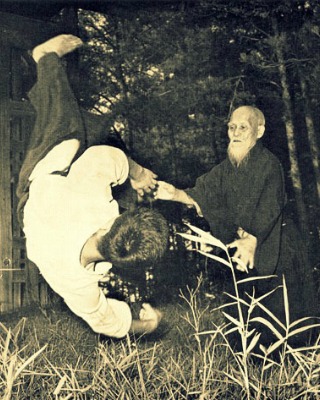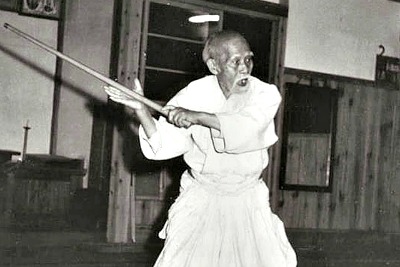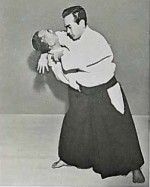The History of Aikido
What is Aikido?
Aikido (meaning the Way of Harmonious Spirit ) is a Japanese martial art that has its roots in the hand-to-hand combat techniques practised by the samurai and more directly in the art of jujitsu.
It was developed by Morihei Ueshiba as a method of self-defence and as a way of life.
It is based on the principle of human unity and is designed to uplift the practitioner by building character and moral fibre.
Talk the Talk
Morihei Ueshiba decided on the name aikido for his new martial art in 1942. Prior to this, it was known as aikibudo and aiki no michi.
 Aikido is a Japanese martial art that teaches practitioners, known as aikidoka, to have a deep sense of harmony with all creation. This includes a would-be attacker, so as a result, there are no attacking movements practised within the art. Instead, students of aikido are taught to subdue their opponent, bringing him under control while inflicting the least amount of injury in the process.
Aikido is a Japanese martial art that teaches practitioners, known as aikidoka, to have a deep sense of harmony with all creation. This includes a would-be attacker, so as a result, there are no attacking movements practised within the art. Instead, students of aikido are taught to subdue their opponent, bringing him under control while inflicting the least amount of injury in the process. To do this, the aikidoka flows with the power and energy of an attack and returns it to its source through good
movement, posture and balance. This is achieved as many aikido techniques utilise circular and spherical movements
designed to redirect opposing forces towards a less harmful direction.
Further Reading:
Aikido – The Way of Harmony. [Internet]. 2018. Stanford University. Available from: http://aikido.stanford.edu/what [Accessed July 19, 2018].
Due to its unique nature, many people ask the question, 'is aikido effective?' and the simple answer is that if you set out with the aim of causing the least amount of harm while still being able to defend yourself, aikido is very effective.
The main principles behind aikido techniques are avoidance, control and neutralisation and students are taught to practice with a
calm mind, a relaxed body and integrated breathing to allow the moves to flow gracefully.
When training,
students are encouraged to treat each other as partners even when one is acting as the attacker and the other practising the defensive moves. This generates an atmosphere of harmony and
cooperation rather than one of competitiveness.
Morihei Ueshiba – Founder of Aikido
Morihei Ueshiba was born in Japan in 1883 and as a boy, witnessed his father being
assaulted by local thugs on numerous occasions. He vowed revenge and dedicated himself to becoming a great fighter and by adulthood, was an accomplished martial artist with expertise in jujitsu as well as the use of the sword, spear and staff.
However, by the time he was grown, he was also a very spiritual man and became conflicted on the contradiction of hurting others, (even within the confines of
martial arts training etiquette), and his belief in being harmonious with all of nature. This apparent paradox would have a profound effect on Ueshiba and would be a defining factor in the history of aikido.
Ueshiba
followed the teachings of Omotokyo, a so-called ‘new religion’ that is part neo-Shintoism, and part socio-political idealism and teaches the core concept of the unification of all of mankind
in a single "heavenly kingdom on earth." He came to believe that winning at another’s expense was not really a victory and spent many hours in meditation and intense study contemplating this
problem.
From the mid-late 1920s, he set out to find movements within Japanese martial arts that would allow him to subdue his opponents without hurting them and compiled them to form a new art that would become known as aikido, meaning the Way of Harmonious Spirit.
Put basically, aikido is a combination of the joint locks and throws from jujitsu combined with the body movements taught in sword and spear fighting. However, this is an oversimplification and it should also be stated that some aikido techniques were invented by Ueshiba himself.
Ueshiba, who is usually referred to as "O’ Sensei" (Great Teacher), spent the rest of his life refining the art to make it accessible to students who were new to martial arts and to those with experience with other forms of fighting while making it deep enough to allow students to continue learning even after many years of training.
From the 1950s, aikido’s popularity grew due to schools founded by some of Morihei Ueshiba’s best students, most notably Koichi Tohei, Gozo Shioda, Minoru Mochizuki, Kenji Tomiki, and Kisshomaru Ueshiba. Today five major styles of the art are collectively practised by millions of people across the world, all of which can trace their roots back to the aforementioned aikido masters.
Written by Andrew Griffiths – Last updated 04/06/2023. If you like
what you see, consider following the History of Fighting on social media.
Further Reading:
Aikido – The Way of Harmony. [Internet]. 2018. Stanford University. Available from: http://aikido.stanford.edu/what [Accessed July 19, 2018]. Eric Sotnak. [Internet] 2018. Aikido Primer. Aikido Karoo. Available from: http://www.aikido.karoo.net/Aikidoprimer.html [Accessed July 19, 2018].
Eric Sotnak. [Internet]. 2018. The History of Aikido. MIT University. Available From: https://aikido.mit.edu/history-aikido [Accessed July 19, 2018].
Harvard Aikikai. [Internet]. 2011. Harvard University. Available from: http://www.hcs.harvard.edu/~aikido/02AIKIDO/AIKIDO.htm [Accessed July 19, 2018].
History of Yoshinkan Aikido. [Internet]. 2018. Makotokan. Available from: http://www.makotokan.com/gpage.html [Accessed July 19, 2018].
Stanley A. Pranin. [Internet]. 1996. Aikido Today: An Overview. OMLC. Available from: https://omlc.org/aikido/talk/overview.html [Accessed July 19, 2018].
More Aikido History
The Five Main Styles of Aikido
Though there are many aikido styles practiced in the world today, most aikidoka train in one of the five main systems of the Japanese martial art. These styles vary in how much emphasis is put on the different aikido techniques, training methods and philosophies but all have evolved from the teachings of aikido’s founder, Morihei Ueshiba.
The images on this site are believed to be in the public domain, however, if any mistakes have been made and your copyright or intellectual rights have been breeched, please contact andrew@articlesonhistory.com.


